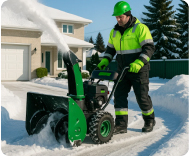A lush, green lawn is the pride of any homeowner, but maintaining it can feel like a daunting task. The good news is that achieving a vibrant yard doesn't require a green thumb—just the right knowledge and a consistent approach. At **PA Lawn Service**, we believe that professional results are within reach. Here are five essential lawn care tips that will help you transform your lawn into the envy of the neighborhood.
1. Mow High and Mow Often
Proper mowing is the cornerstone of a healthy lawn. The best practice is to set your mower blade high, usually between 2.5 and 3 inches. **Mowing high** encourages grass to develop deeper, more resilient root systems, which helps it withstand drought and heat. A common mistake is to "scalp" the lawn by cutting it too short, which can stress the grass and leave it vulnerable to weeds and disease. Aim to cut no more than one-third of the blade at a time, and be sure your mower blades are sharp to make a clean cut. Dull blades tear the grass, leading to frayed, brown tips.
2. Water Deeply and Infrequently
For a strong, healthy lawn, it's better to water less often but for a longer duration. This practice, known as **deep watering**, encourages roots to grow down deep into the soil to seek moisture, making your lawn more drought-resistant. Most lawns need about 1 to 1.5 inches of water per week, including rainfall. The best time to water is in the early morning (before 10 a.m.). This allows the water to soak into the soil before the sun evaporates it and gives the grass blades time to dry, which helps prevent fungal diseases.
3. Fertilize on a Schedule
A lawn, like any living thing, needs food to thrive. Fertilizing provides the essential nutrients—nitrogen, phosphorus, and potassium—that promote strong growth and a deep green color. For most lawns, a **twice-a-year fertilization schedule** is ideal: once in the spring to fuel growth after winter, and again in the fall to prepare the lawn for dormancy. Always follow the product instructions carefully to avoid over-fertilizing, which can burn your grass and create an unhealthy thatch buildup. The right fertilizer at the right time is your lawn's best defense against weeds and disease.
4. Control Weeds Early
Weeds compete with your grass for water, nutrients, and sunlight, so staying on top of them is crucial. The most effective strategy is a combination of **pre-emergent and post-emergent control**. A pre-emergent herbicide, applied in the early spring, creates a barrier in the soil that prevents weed seeds from germinating. For any weeds that do sprout, spot-treating them with a targeted herbicide or simply pulling them by hand is an effective way to keep your lawn clean and tidy. The thicker and healthier your grass is, the harder it will be for weeds to take root in the first place.
5. Don't Skip Seasonal Cleanups
A healthy lawn requires year-round attention. In the **fall**, it's essential to rake up fallen leaves and debris. Leaving a thick layer of leaves on your lawn can suffocate the grass, trap moisture, and invite fungal growth. This is also a great time for aeration and overseeding to help the lawn recover from summer stress. In the **spring**, a quick cleanup of any remaining debris will help kick off the new growing season right. These simple seasonal tasks ensure your lawn remains resilient and ready for whatever the weather brings.



